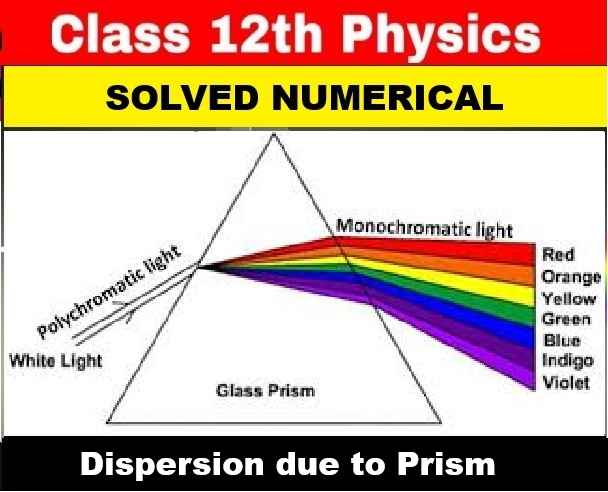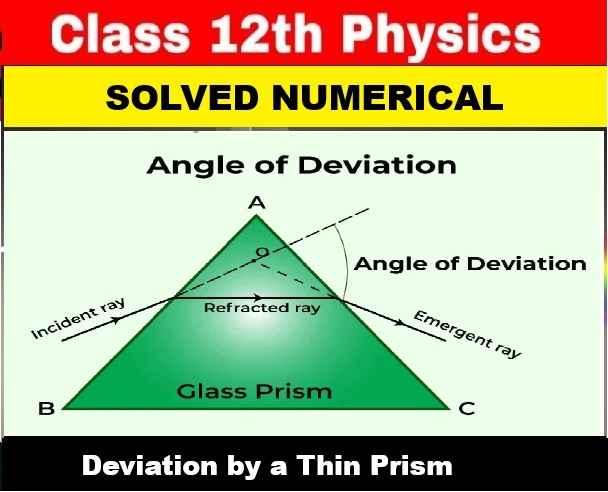ML Aggarwal Triangles Chapter Test for ICSE Class 9 Maths Solutions Ch-10. Step by Step Answer of Ch-Test Questions of Triangles for ML Aggarwal ICSE Class 9th Mathematics. Visit official website CISCE for detail information about ICSE Board Class-9.
ML Aggarwal Triangles Chapter Test for ICSE Class 9 Maths Solutions Ch-10
| Board | ICSE |
| Subject | Maths |
| Class | 9th |
| Chapter-10 | Triangles |
| Topics | Solution of Ch-Test Questions |
| Academic Session | 2024-2025 |
Solution of Ch-Test Questions
ML Aggarwal Triangles for ICSE Class 9 Maths Solutions Ch-10
Question 1. In triangles ABC and DEF, ∠A = ∠D, ∠B = ∠E and AB = EF. Will the two triangles be congruent? Give reasons for your answer.
Answer : In ∆ABC and ∆DEF
∠A = ∠D
∠B = ∠E
AB = EF
In ∆ABC, two angles and included side is
Given but in ∆DEF, corresponding angles are
Equal but side is not included of there angle.
Triangles cannot be congruent.
Question 2. In the adjoining figure, ABCD is a square. P, Q and R are points on the sides AB, BC and CD respectively such that AP= BQ = CR and ∠PQR = 90°. Prove that
(a) ∆PBQ ≅ ∆QCR
(b) PQ = QR
(c) ∠PRQ = 45°
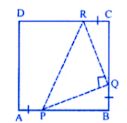
Answer : From the figure, ABCD is a square
P,Q and R are the Points on the sides AB,
BC and CD respectively such that
AP = BQ = CR, ∠PQR = 90o
To prove: (a) ∆PBQ = ∆QCR
(b) PQ = QR
(c) ∠PQR = 45o
Proof:
AB = BC = CD (Sides of Square)
And AP = BQ = CR (Given)
Subtracting, we get
AB – AP = BC – BQ = CD – CR (PB = QC = RD)
Now in ∆PBQ and ∠QCR
PB = QC (Proved)
BQ = CR (Given)
∠B = ∠C (Each 90o)
∆PBQ ≅ ∆QCR
PQ = QR
But ∠PQR = 90o
∠RPQ = ∠PQR (Angles opposite to equal angles)
But,
∠RPQ + ∠PRQ = 90o
⇒ ∠RPQ = ∠PQR = 90o
⇒ ∠RPQ = ∠PRQ = 90o/2 = 45o
Question 3. In the given figure, OA ⊥ OD, OC X OB, OD = OA and OB = OC. Prove that AB = CD.
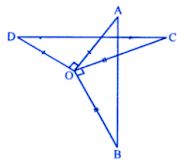
Answer : From the figure OA ⊥ OD, OC ⊥ OB.

∠AOD = ∠COB (each 90o)
Adding ∠AOC
∠AOD + ∠AOC = ∠AOC + ∠COB
⇒ ∠COD = ∠AOB
Now, in ∆AOB and ∆DOC
OA = OD (Given)
OB = OC (Given)
∠AOB = ∠COD (Proved)
∆AOB ≅ ∆DOC
AB = CD
Question 4. In the given figure, PQ || BA and RS CA. If BP = RC, prove that:
(i) ∆BSR ≅ ∆PQC
(ii) BS = PQ
(iii) RS = CQ.
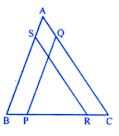
Answer :
PQ ∥ BA, RS ∥ CA
BP = RC
To prove :
(i) ∆BSR ≅ ∆PQC
(ii) RS = CQ
Proof:
BP = RC
⇒ BC – RC = BC – BP
⇒ BR = PC
Now, in ∆BSR and ∆PQC
∠B = ∠P (Corresponding angles)
∠R = ∠C (Corresponding angles)
BR = PC (Proved)
∆BSR ≅ ∆PQC
BS = PQ
RS = CQ
Question 5. In the given figure, AB = AC, D is a point in the interior of ∆ABC such that ∠DBC = ∠DCB. Prove that AD bisects ∠BAC of ∆ABC.
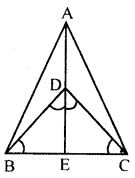
Answer : Since AB = AC
∠ABC = ∠ACB
But ∠DBC = ∠DBC
⇒ ∠ABD = ∠ACD
Now in ΔABD and ΔADC
AB = AC
AD = AD
∠ABD = ∠ACD
Therefore, ΔABD ≅ ΔADC …(SSA criteria)
Hence, ∠BAD = ∠CAD
Thus, AD bisects ∠BAC.
Question 6. In the adjoining figure, AB || DC. CE and DE bisects ∠BCD and ∠ADC respectively. Prove that AB = AD + BC.
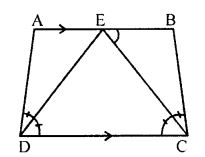
Answer : DE Bisect ∠D
∠EDA = ∠EDC = ∠D/2
AB ║ CD & DE is line cutting these parallel lines
∠DEA = ∠EDC = ∠D/2
in Δ ADE
∠EDA & ∠DEA = ∠D/2
Hence AD = AE
Similarly
in Δ BCE
∠ECB = ∠CEB = ∠C/2
BE = BC
AB = AE + BE = AD + BC
AB = AD + BC
Question 7. In ∆ABC, D is a point on BC such that AD is the bisector of ∠BAC. CE is drawn parallel to DA to meet BD produced at E. Prove that ∆CAE is isosceles.
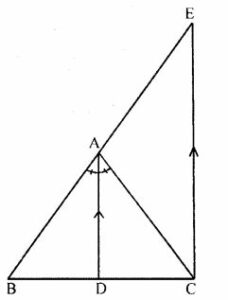
Answer :
∠BAC + ∠EAC = 180° ( Straight line)
in ΔACE
∠ACE + ∠AEC + ∠EAC = 180° ( sum of angles of Triangle)
Equating both
∠BAC + ∠EAC = ∠ACE + ∠AEC + ∠EAC
∠BAC = ∠ACE + ∠AEC Eq 1
∠BAD = (1/2) ∠BAC
∠BAD = ∠AEC ( AD ║ CE)
∠AEC = (1/2) ∠BAC
putting this in eq 1
∠BAC = ∠ACE + (1/2) ∠BAC
∠ACE = (1/2) ∠BAC
∠AEC = ∠ACE = (1/2) ∠BAC
AC = AE
Hence Δ CAE is an isosceles triangle
Question 8. In the figure (ii) given below, ABC is a right angled triangle at B, ADEC and BCFG are squares. Prove that AF = BE.
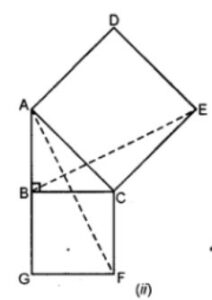
Answer : To prove : AE = BE
angle ACE = angle BCF
adding angle ACB both side
angle ACE +angle ACB = angle BCF + angle ACB
angle BCE = angle ACF
in ∆ BCE and ∆ACF
BC = CF ( square sides)
CE = AF ( square sides)
angle BCE = angle ACF
∆ BCD and ∆ ACF are congruent triangle
BE= AF
Hence Proved
Question 9. In the given figure, BD = AD = AC. If ∠ABD = 36°, find the value of x .
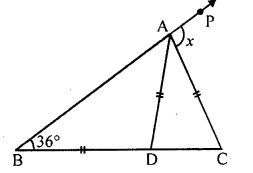
Answer :
Since x is an exterior angle
So we can say,
x = ∠ABD + ∠ ACD
AC = AD = AC
AB = AC
∠ABD = ∠ACD ( 36° = 36°)
x = 36° + 36°
x = 72°
Hence, the value of x is 72° .
Question 10 In the adjoining figure, TR = TS, ∠1 = 2∠2 and ∠4 = 2∠3. Prove that RB = SA.
Answer : Given: In the figure , RST is a triangle
RT = TS ……..(1)
∠1 = 2∠2 ……..(2)
And∠4 = √2 …………….(3)
And given to prove ΔRBT≅ ΔSAT
Let the point of intersection of RB and SA be denoted by O Since RB and SA intersect at O.
∴∠AOR = ∠BOS [Vertically opposite angles]
⇒∠1 = ∠4
⇒ 2∠2 = 2∠3 [From (2) and (3)
∠2 = ∠3 ……..(4)
Now we have RT = TS ∠∠TRS
∴ΔTRS is an isosceles triangle
∴∠TRS = ∠TSR ……..(5) [Angles opposite to equal sides are equal]
But we have
∠TRS = ∠TRB + ∠2 ………(6)
And ∠TSR = ∠TSA + ∠3 ……….(7)
Putting (6) and (7) in (5) we get
∠TRB +∠2 = ∠TSA + ∠B
⇒∠ TRB =∠TSA [∵ From (4)]
Now considerΔRBT and ΔSAT
RT = ST …. [From (1)]
∠TRB = ∠TSA …. [From (4)]
∠RTB =∠ STA [Common angle]
From ASA criterion of congruence, we have ΔRBT ≅ΔSAT
Question 11 .
(a) In the figure (1) given below, find the value of x.
(b) In the figure (2) given below, AB = AC and DE || BC. Calculate
(i)x
(ii) y
(iii) ∠BAC
(c) In the figure (1) given below, calculate the size of each lettered angle.
Answer: Update soon
Question 12.
(a) In the figure (1) given below, AD = BD = DC and ∠ACD = 35°. Show that
(i) AC > DC (ii) AB > AD.
(b) In the figure (2) given below, prove that
(i) x + y = 90° (ii) z = 90° (iii) AB = BC
Answer: Update soon
Question 13. In the adjoining figure, ABC and DBC are two isosceles triangles on the same base BC and vertices A and D are on the same side of BC. If AD is extended to intersect BC at P, show that
(i) ∆ABD ≅ ∆ACD
(ii) ∆ABP ≅ ∆ACP
(iii) AP bisects ∠A as well as ∠D
(iv) AP is the perpendicular bisector of BC.
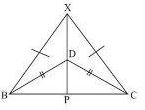
Answer : (i) In △ABD and △ACD,
AB=AC ….(since △ABC is isosceles)
AD=AD ….(common side)
BD=DC ….(since △BDC is isosceles)
ΔABD≅ΔACD …..SSS test of congruence,
∴∠BAD=∠CAD i.e. ∠BAP=∠PAC …..[c.a.c.t]……(i)
(ii) In △ABP and △ACP,
AB=AC …(since △ABC is isosceles)
AP=AP …(common side)
∠BAP=∠PAC ….from (i)
△ABP≅△ACP …. SAS test of congruence
∴BP=PC …[c.s.c.t]…..(ii)
∠APB=∠APC ….c.a.c.t.
(iii) Since △ABD≅△ACD
∠BAD=∠CAD ….from (i)
So, AD bisects ∠A
i.e. AP bisects ∠A…..(iii)
In △BDP and △CDP,
DP=DP …common side
BP=PC …from (ii)
BD=CD …(since △BDC is isosceles)
△BDP≅△CDP ….SSS test of congruence
∴∠BDP = ∠CDP ….c.a.c.t.
∴ DP bsects ∠D
So, AP bisects ∠D ….(iv)
From (iii) and (iv),
AP bisects ∠A as well as ∠D.
(iv) We know that
∠APB+∠APC=180 ….(angles in linear pair)
Also, ∠APB=∠APC …from (ii)
∴∠APB=∠APC = =90°
BP = PC and ∠APB = ∠APC = 90°
Hence, AP is perpendicular bisector of BC.
Question 14. In the given figure, AP ⊥ l and PR > PQ. Show that AR > AQ.
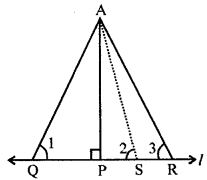
Answer : Given: PR > PQ
Apply Pythagoras theorem in triangle APQ,
AP² = AQ² – PQ² … (1)
Apply Pythagoras theorem in triangle APR,
AP² = AR² – PR² … (2)
From equation (1) and (2),
AR² – PR² = AQ² – PQ²
Given PR > PQ, So,
AR² – PQ² > AQ² – PQ²
AR² > AQ²
AR > AQ
Hence Proved.
Question 15. If O is any point in the interior of a triangle ABC, show that
OA + OB + OC > 1/2 (AB + BC + CA).
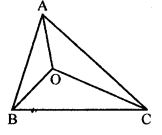
Answer : According to triangle inequality, sum of any two sides is greater than the third side. Therefore,
OA+OB > AB ……(1)
OB+OC > BC ……(2)
OC+OA > AC ……(3)
Adding (1), (2) and (3), we get
2(OA+OB+OC) > (AB+BC+AC)
Dividing both sides by 2, we get
(OA+OB+OC) > 1/2(AB+BC+AC).
— : End of ML Aggarwal Triangles Chapter Test Class 9 ICSE Maths Solutions :–
Return to :- ML Aggarawal Maths Solutions for ICSE Class-9
Thanks
Please Share with Your Friends

